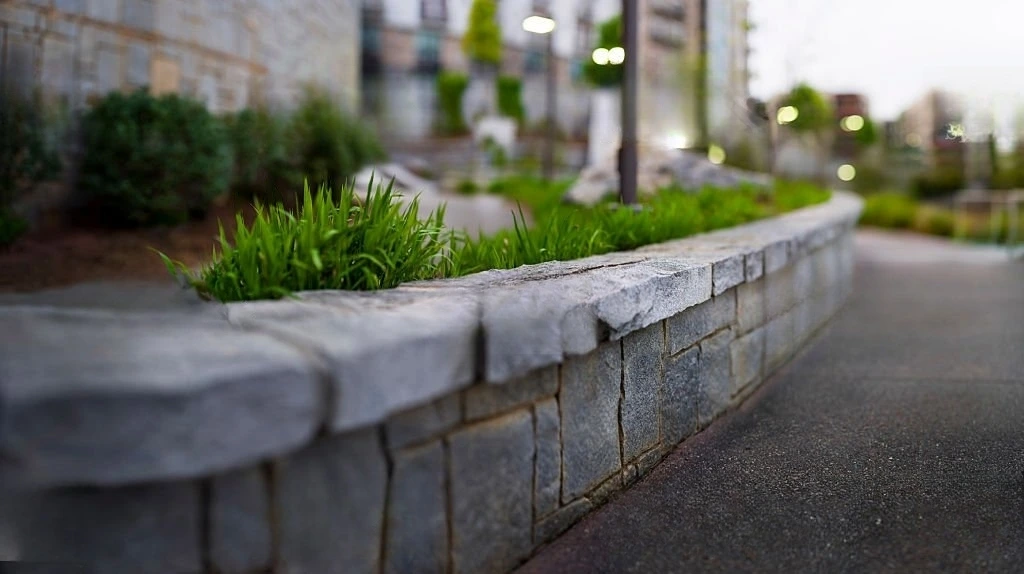Retaining wall are structures that are designed to maintain or hold back soil and prevent erosion in areas where there are steep slopes. They are commonly used in landscaping projects and are built to provide a stable and secure foundation for buildings, roads, and other structures. Retaining walls can be constructed using various materials, including concrete, stone, brick, wood, and more.
One of the primary reasons why retaining walls are constructed is to prevent soil erosion. This is especially important in areas where the ground is sloped or with a landslide risk.
Another reason why retaining walls are built is to create usable space. A sloping yard or hillside can often be challenging to use or enjoy. By constructing a retaining wall, homeowners and property owners can level out their property and create a flat surface that can be used for gardening, outdoor living, or other purposes.
Retaining walls are also often used in the construction of roads and highways. They can provide a stable foundation for the road and prevent soil erosion from causing damage to the road or surrounding areas.
If you are considering building a retaining wall. It is essential to work with experienced contractors who can help you design and construct a fence that meets your needs and is built to last. Choosing the suitable materials and construction methods ensures. Your retaining wall provides the stability and functionality you need for years.
Why The Retaining Wall Collapse?
Retaining walls are structures designed to hold back soil or other materials and prevent them from sliding or eroding. They are commonly used in landscaping and construction projects to create level surfaces, prevent soil erosion, and add aesthetic appeal to the property. However, retaining walls can collapse for various reasons, posing serious safety hazards and costly damages.
One of the most common reasons for retaining wall collapse is poor construction. The retaining wall contractors may not have followed the necessary design and engineering specifications, leading to weak and unstable structures. Additionally, the quality of construction materials can affect the wall’s integrity. If defective materials are used, the wall may not withstand the pressure of the soil and water behind it, leading to failure.
Another reason for retaining wall collapse is poor drainage. If water is not adequately drained away from the wall, it can seep into the soil behind it, causing it to become saturated and heavy. This excess weight can cause the wall to buckle and collapse. Similarly, poor grading can also contribute to retaining wall failure. If the slope of the land is not adequately accounted. It can put additional pressure on the wall and cause it to fail.
Natural factors such as earthquakes and heavy rainfall can also contribute to retaining wall collapse. While these factors are often unpredictable, they can have devastating effects on poorly designed and constructed retaining walls.
Retaining wall collapse can have serious consequences; taking measures to prevent it is essential. Hiring experienced and reputable retaining wall contractors and ensuring proper drainage and grading are just a few ways to reduce the risk of having wall failure.
Why Curved The Retaining Wall?
Retaining walls are essential to landscaping and construction, used to hold back soil and prevent erosion. There are many options for choosing a retaining wall design, but one style that has gained popularity in recent years is curved retaining walls.
So why choose a curved retaining wall over a straight one? For starters, a curved design adds an element of elegance and visual interest to your outdoor space. A curved retaining wall’s gentle curves and flowing lines can create a sense of movement and fluidity. Make it a beautiful addition to any garden or landscape.
Another advantage of a curved retaining wall is its versatility. It can be used in various settings and made from a range of materials, including concrete, stone, or brick. This means you can customize the design to suit your needs and preferences.
Suppose you’re considering a curved retaining wall for your property. In that case, it’s essential to work with experienced retaining wall contractors. Who can help you design and install a fence that is both beautiful and functional. With the right design and construction. A curved retaining wall can be a valuable investment in your outdoor space’s long-term health and beauty.
Why Retaining Wall Designed For Active Pressure?
A retaining wall is a structure designed to keep soil, rock, or other materials from sliding or eroding. It is commonly used to create level areas on sloped landscapes or to prevent soil erosion on hillside properties. Retaining walls can be constructed using various materials, such as concrete, stone, brick, or timber. However, regardless of the material used, retaining walls are typically designed to withstand the active pressure that the soil exerts on them.
The active pressure on a retaining wall is caused by the weight of the soil and the forces exerted by the water in the ground. If a retaining wall is not designed to withstand this pressure. It can fail and cause significant damage to the surrounding area. This is why hiring experienced retaining wall contractors who can design and build a retaining wall that can withstand the active pressure is crucial.
There are several factors that retaining wall contractors consider when designing a retaining wall. They take into account the type of soil on the site, the slope of the land. The amount of water that will be present, and the weight of the ground that the wall will need to hold back. By considering these factors, contractors can design a retaining wall that will effectively withstand the active pressure and prevent soil erosion.
Retaining walls are designed for active pressure to prevent soil erosion and ensure the safety of the surrounding area. Hiring experienced contractors is crucial to ensuring that the retaining wall is designed and built to withstand the active pressure.





